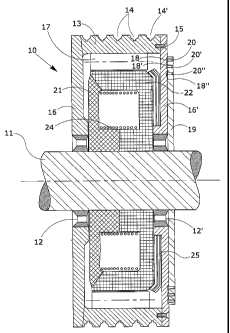Une partie des informations de ce site Web a été fournie par des sources externes. Le gouvernement du Canada n'assume aucune responsabilité concernant la précision, l'actualité ou la fiabilité des informations fournies par les sources externes. Les utilisateurs qui désirent employer cette information devraient consulter directement la source des informations. Le contenu fourni par les sources externes n'est pas assujetti aux exigences sur les langues officielles, la protection des renseignements personnels et l'accessibilité.
L'apparition de différences dans le texte et l'image des Revendications et de l'Abrégé dépend du moment auquel le document est publié. Les textes des Revendications et de l'Abrégé sont affichés :
| (12) Brevet: | (11) CA 2629630 |
|---|---|
| (54) Titre français: | MOTEUR ELECTRIQUE AVEC UN FAIBLE NOMBRE DE REVOLUTIONS, EN PARTICULIER POUR ENTRAINER DES DISPOSITIFS DE LEVAGE |
| (54) Titre anglais: | ELECTRIC MOTOR WITH A LOW NUMBER OF REVOLUTIONS, IN PARTICULAR TO DRIVE LIFTING DEVICES |
| Statut: | Réputé périmé |
| (51) Classification internationale des brevets (CIB): |
|
|---|---|
| (72) Inventeurs : |
|
| (73) Titulaires : |
|
| (71) Demandeurs : |
|
| (74) Agent: | BERESKIN & PARR LLP/S.E.N.C.R.L.,S.R.L. |
| (74) Co-agent: | |
| (45) Délivré: | 2011-07-26 |
| (86) Date de dépôt PCT: | 2007-03-19 |
| (87) Mise à la disponibilité du public: | 2007-11-15 |
| Requête d'examen: | 2008-04-23 |
| Licence disponible: | S.O. |
| (25) Langue des documents déposés: | Anglais |
| Traité de coopération en matière de brevets (PCT): | Oui |
|---|---|
| (86) Numéro de la demande PCT: | PCT/IB2007/000669 |
| (87) Numéro de publication internationale PCT: | WO2007/129150 |
| (85) Entrée nationale: | 2008-04-21 |
| (30) Données de priorité de la demande: | ||||||||||||
|---|---|---|---|---|---|---|---|---|---|---|---|---|
|
La présente invention concerne un moteur électrique (10) avec un faible nombre de révolutions qui comprend un rotor (17) alimenté par tension alternative triphasée, une série d'aimants (21, 22) et une bobine qui forme un stator (24), dans lequel le rotor (17) et le stator (24) possèdent le même nombre de pôles magnétiques. Le stator (24) est alimenté avec une tension directe, et la fréquence de la tension de rotor (17) est variée pour obtenir un nombre prédéterminé de tr/min du moteur et pour varier les conditions d'accélération et de décélération du moteur. Un palier de butée s'oppose à l'effort du disque de frein qui tombe.
An electric motor (10) with a low number of revolutions comprises a rotor (17)
powered by three-phase alternating voltage, a series of magnets (21, 22) and a
coil forming a stator (24), in which the rotor (17) and the stator (24) have
the same number of magnetic poles. The stator (24) is powered with direct
voltage, and the frequency of the rotor voltage (17) is varied to obtain a
predetermined number of rpm of the motor and to vary the acceleration and
deceleration conditions of the motor. A thrust bearing opposes the effort of
the falling brake disc.
Note : Les revendications sont présentées dans la langue officielle dans laquelle elles ont été soumises.
Note : Les descriptions sont présentées dans la langue officielle dans laquelle elles ont été soumises.

Pour une meilleure compréhension de l'état de la demande ou brevet qui figure sur cette page, la rubrique Mise en garde , et les descriptions de Brevet , États administratifs , Taxes périodiques et Historique des paiements devraient être consultées.
| Titre | Date |
|---|---|
| Date de délivrance prévu | 2011-07-26 |
| (86) Date de dépôt PCT | 2007-03-19 |
| (87) Date de publication PCT | 2007-11-15 |
| (85) Entrée nationale | 2008-04-21 |
| Requête d'examen | 2008-04-23 |
| (45) Délivré | 2011-07-26 |
| Réputé périmé | 2015-03-19 |
Il n'y a pas d'historique d'abandonnement
| Type de taxes | Anniversaire | Échéance | Montant payé | Date payée |
|---|---|---|---|---|
| Le dépôt d'une demande de brevet | 200,00 $ | 2008-04-21 | ||
| Requête d'examen | 400,00 $ | 2008-04-23 | ||
| Taxe de maintien en état - Demande - nouvelle loi | 2 | 2009-03-19 | 100,00 $ | 2009-02-20 |
| Taxe de maintien en état - Demande - nouvelle loi | 3 | 2010-03-19 | 100,00 $ | 2010-02-08 |
| Taxe de maintien en état - Demande - nouvelle loi | 4 | 2011-03-21 | 100,00 $ | 2011-02-10 |
| Taxe finale | 300,00 $ | 2011-05-04 | ||
| Taxe de maintien en état - brevet - nouvelle loi | 5 | 2012-03-19 | 200,00 $ | 2012-02-23 |
| Taxe de maintien en état - brevet - nouvelle loi | 6 | 2013-03-19 | 200,00 $ | 2013-02-21 |
Les titulaires actuels et antérieures au dossier sont affichés en ordre alphabétique.
| Titulaires actuels au dossier |
|---|
| JEZEK, GIORGIO |
| Titulaires antérieures au dossier |
|---|
| S.O. |